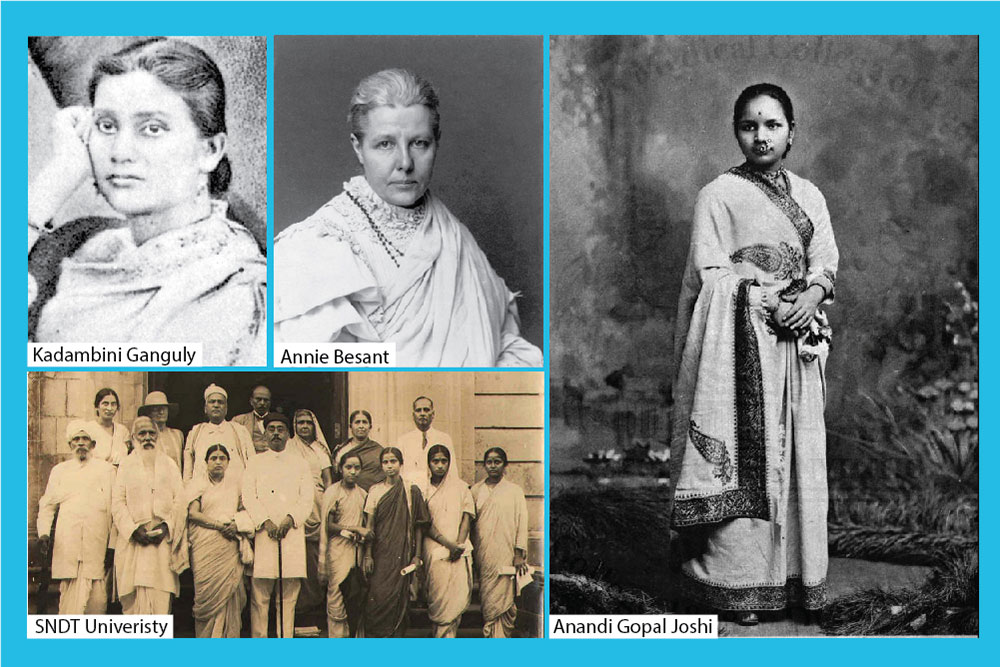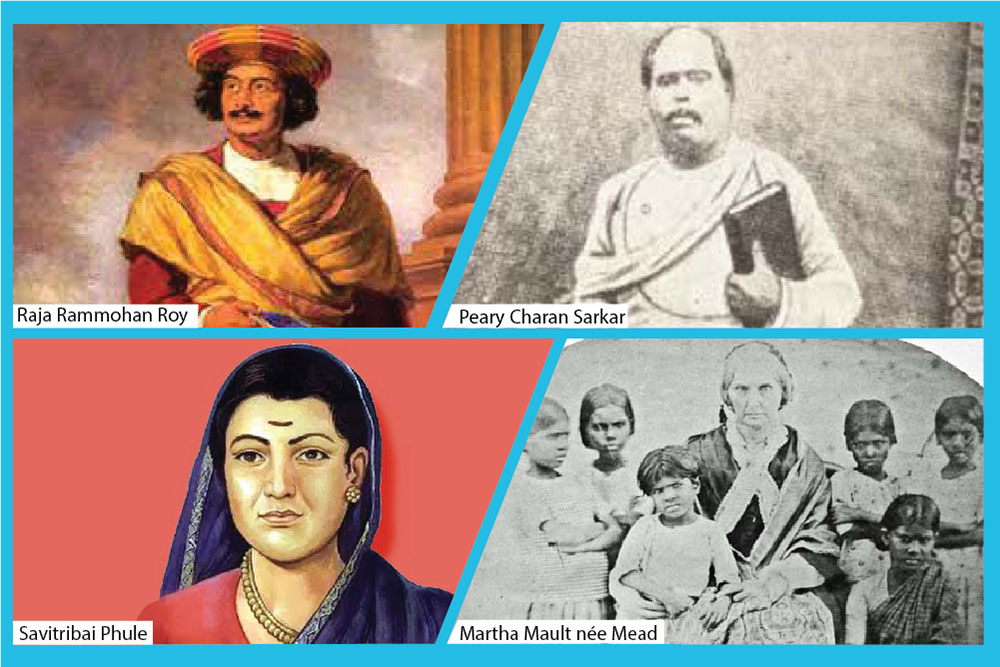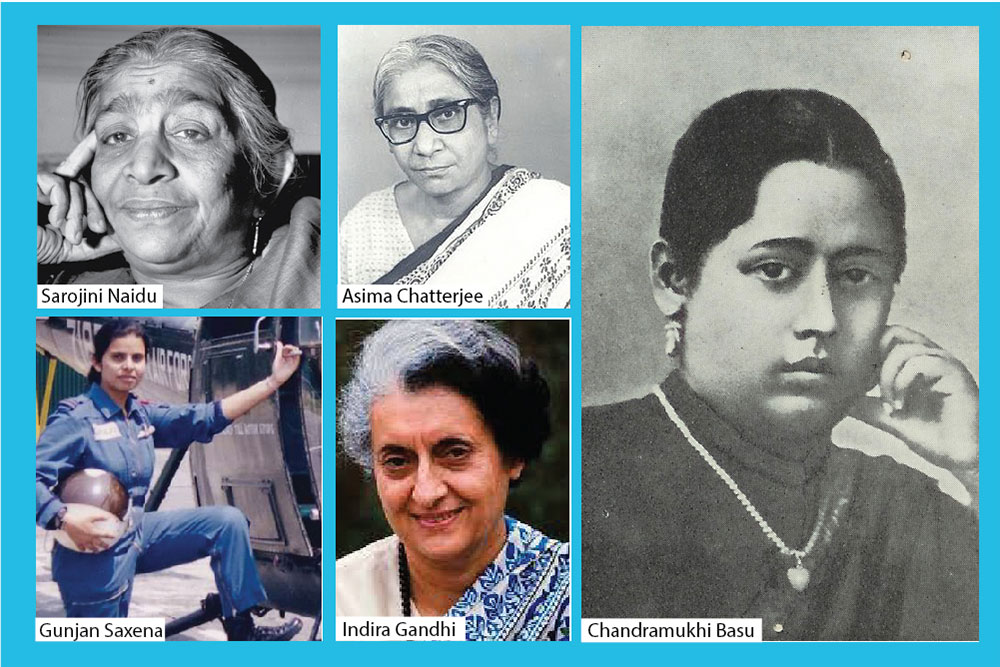Women's rights is multicultural and diasporic. The struggles of women from different geographies are dissimilar and are conditioned by several factors: familial, societal, racial, marital, economic, religious, cultural and individual consciousness. Patriarchy and misogyny is deeply rooted in ancients as well as modern-day India - Indian women negotiate survival through an array of oppressive societal structures: age, ordinal status, relationship to men through family of origin, marriage and procreation, and patriarchal attributes. Examples of patriarchal attributes include dowry, siring sons, kinship, caste, colour, community, village, market, and the state. Despite the challenges, India has a long tradition of women who rebelled against conformism under severe societal pressures.
The history of women in India can be divided into three phases: the first phase, beginning in the mid-19th century, initiated when reformists began to speak in favour of women rights by making reforms in education, customs involving women; the second phase, from 1915 to Indian independence, when Mahatma Gandhi incorporated women's movements into the Quit India movement and independent women's organisations began to emerge; and finally, the third phase, post-independence, which has focused on fair treatment of women at home after marriage, in the work force, and right to political parity.
Despite the advancements, many problems still remain which inhibit women from fully taking advantage of rights and opportunities in India. Religious laws and expectations, or personal laws enumerated by each specific religion, often conflict with the Indian Constitution, eliminating rights and powers women should legally have. Even though there still remains a lot of work to be done, the movement to secure rights for women in India has come a long way.
First Phase: 1825–1915

The colonial venture into modernity and the rise of nationalism and introspection of discriminatory practices brought about social reform movements related to caste and gender. This first phase of women’s freedom and rights in India was initiated by men to uproot the social evils of sati, to allow widow remarriage, to forbid child marriage, and to reduce illiteracy, as well as to regulate the age of consent and to ensure property rights through legal intervention. In addition to this, some upper caste Hindu women rejected constraints they faced under Brahminical traditions. Several Indian states were ruled by women during British colonial advance including Jhansi (Rani Laxmibai), Kittur (Rani Chennama), Bhopal (Quidisa Begum) and Punjab (Jind Kaur). During the British Raj, many reformers such as Ram Mohan Roy, Ishwar Chandra Vidyasagar and Jyotirao Phule fought for the betterment of women.
• Raja Rammohan Roy's efforts led to the abolition of Sati under Governor-General William Cavendish-Bentinck in 1829.
• Peary Charan Sarkar, a former student of Hindu College, Calcutta and a member of 'Young Bengal', set up the first free school for girls in India in 1847 in Barasat, a suburb of Calcutta (later the school was named Kalikrishna Girls' High School).
• 1848, Savitribai Phule, along with her husband Jyotirao Phule, opened a school for girls in Pune, India. Savitribai Phule became the first woman teacher in India.
• Missionaries' wives such as Martha Mault née Mead and her daughter Eliza Caldwell née Mault are rightly remembered for pioneering the education and training of girls in south India. This practice was initially met with local resistance, as it flew in the face of tradition.
• The Female Infanticide Prevention Act, 1870, also Act VIII of 1870 was a legislative act passed in British India, to prevent murder of female infants.
• Ishwar Chandra Vidyasagar's crusade for improvement in the situation of widows led to the Widow Remarriage Act of 1856. Many women reformers such as Pandita Ramabai also helped the cause of women
• In 1879, John Elliot Drinkwater Bethune established the Bethune School in 1849, which developed into the Bethune College in 1879, thus becoming the first women's college in India.
• In 1883, Chandramukhi Basu and Kadambini Ganguly became the first female graduates of India and the British Empire.
• Kadambini Ganguly and Anandi Gopal Joshi became the first women from India to be trained in Western medicine in 1886
Second Phase: 1915–1947

During this period the struggle against colonial rule intensified. Nationalism became the pre-eminent cause. Mahatma Gandhi legitimised and expanded Indian women's public activities by initiating them into the non-violent civil disobedience movement against the British Raj. He dignified their feminine roles of caring, self-abnegation, sacrifice and tolerance; and carved a niche for those in the public arena. Peasant women played an important role in the rural satyagrahas of Borsad and Bardoli. Women-only organisations like All India Women's Conference (AIWC) and the National Federation of Indian Women (NFIW) emerged. Women were grappling with issues relating to the scope of women's political participation, women's franchise, communal awards, and leadership roles in political parties.
• The first women's university, SNDT Women's University, was founded on 2 June 1916 by the social reformer Dhondo Keshav Karve with just five students.
• In 1917, the first women's delegation met the Secretary of State to demand women's political rights, supported by the Indian National Congress. Annie Besant became the first female president of the Indian National Congress.
• In 1925, Sarojini Naidu became the first Indian born female president of the Indian National Congress.
• The All India Women's Conference was founded in 1927
• Child marriage was outlawed in 1929, under Indian law and women’s legal age to marry was set at 14 years
• In 1944, Asima Chatterjee became the first Indian woman to be conferred the Doctorate of Science by an Indian university.
• On 15 August 1947, following independence, Sarojini Naidu became the governor of the United Provinces, and in the process became India's first woman governor. On the same day, Amrit Kaur assumed office as the first female Cabinet minister of India in the country's first cabinet.
Feminist agendas and movements became less active right after India's 1947 independence, as the nationalist agendas and movements on nation building took precedence over feminist issues. These movements resisted 'colonial interventions' particularly, in the mid to late nineteenth century, there was a national form of resistance to any colonial efforts made to 'modernise' the Hindu family. This included the Age of Consent controversy that erupted after the British tried to raise the age of marriage for women to avoid minors from forced marriages and sexual acts.
Post 1947

Women's participation in the struggle for freedom developed their critical consciousness about their role and rights in independent India. Women in the 1970s challenged the inequalities that had been established and fought to reverse them. These inequalities included unequal wages for women, relegation of women to 'unskilled' spheres of work, and restricting women as a reserve army for labour. The aim was to abolish the free service of women who were essentially being used as cheap capital. Women also began recognising the inequalities not just between genders but also within power structures such as caste, tribe, language, religion, region and class thus began efforts to ensure that fulfilling the demands of one group would not create further inequalities for another. Now, in the early twenty-first century, the focus of the Indian woman has gone beyond treating women as useful members of society and a right to parity, but also having the power to decide the course of their personal lives and the right of self-determination.
• The Immoral Traffic (Prevention) Act was passed in 1956, to prohibit trafficking of young girls and women
• In 1961, the Government of India passed the Dowry Prohibition Act, making dowry demands in wedding arrangements illegal.
• In 1966 Indira Gandhi became the first female Prime Minister of India. She served as prime minister of India for three consecutive terms (1966–77) and a fourth term from 1980 until she was assassinated in 1984.
• India passed the Equal Remuneration Act in 1976, which prohibits discrimination in remuneration on grounds of sex
• Women's age of marriage was increased from 14 years to 18 years in 1978 by amending the Sharda Act of 1929
• The Indian Armed Forces began recruiting women to non-medical positions in 1992
• The Protection of Women from Domestic Violence Act 2005 was brought into force by the Indian government from 26 October 2006. The Act for the first time recognises a definition of 'domestic violence', with this definition being broad and including not only physical violence, but also other forms of violence such as emotional/verbal, sexual, and economic abuse.
• In 2013, the Criminal Law (Amendment) Act, 2013 introduced changes to the Indian Penal Code, making sexual harassment an expressed offence under Section 354 A, which is punishable up to three years of imprisonment and or with fine. The Amendment also introduced new sections making acts like disrobing a woman without consent, stalking and sexual acts by person in authority an offense
• The Sexual Harassment of Women at Workplace (Prevention, Prohibition and Redressal) Act came into force in December 2013, to prevent Harassment of women at workplace
• In 2013, the Supreme Court of India held that the two-finger test on a rape victim violates her right to privacy, and asked the Delhi government to provide better medical procedures to confirm sexual assault.
• In 2015, the Indian government announced that women could serve as fighter pilots in the Indian Air Force (IAF)
• In 2016 a judgment of the Delhi high court was made public in which it was ruled that the eldest female member of a Hindu Undivided Family can be its 'Karta'.
• In 2020, the Supreme Court of India said that women officers in the Indian Army can get command positions at par with male officers.
Challenges and Triumphs
Despite progress, challenges such as gender-based violence, discrimination, and limited access to education and healthcare persist. This section highlights the ongoing struggles and remarkable achievements in the quest for gender equality in India. Despite progress, women in India continue to face challenges such as gender-based violence, unequal access to education, and limited economic opportunities. The persistence of these challenges underscores the need for ongoing efforts to promote and protect women's rights.
Future of Women's Rights in India
The future of women's rights in India holds the promise of greater empowerment and gender equality. Initiatives to bridge gender gaps, improve access to education and healthcare, and create a safer environment for women are on the horizon. The future of women's rights in India is a hopeful one, with a growing awareness of the importance of gender equality. Initiatives aimed at bridging gender gaps in education, employment, and healthcare are being implemented, offering a promising outlook for women's rights in the country.
Role Of Judiciary In Recognizing Women's Rights
The history and evolution of women's rights in India is a complex and multifaceted journey that spans centuries. Women's rights in India have evolved through various historical, social, and legal developments. The role of the judiciary has been pivotal in recognizing and upholding these rights. Here's an overview of the history and evolution of women's rights in India with a focus on the role of the judiciary:
Ancient and Medieval Period:
Ancient Laws: Ancient Indian texts, such as the Rigveda and Manusmriti, contained laws and guidelines related to women's status and rights. While some texts reflected a more liberal approach, others were regressive in their treatment of women.
Property Rights: Women in ancient India had property rights, including the right to inherit and own property. However, over time, these rights eroded, especially during the medieval period.
Colonial Era:
British Influence: The colonial period introduced new legal codes, such as the Hindu Succession Act and the Indian Succession Act, which impacted women's property rights. These laws were criticized for their gender bias.
Social Reform Movements: The 19th century witnessed social reform movements, led by figures like Raja Ram Mohan Roy and Ishwar Chandra Vidyasagar, advocating for women's rights, including the right to education and remarriage.
Post-Independence:
Constitution of India: The Indian Constitution, adopted in 1950, enshrined fundamental rights for all citizens, regardless of gender. It abolished untouchability and prohibited discrimination based on sex.
Landmark Legal Reforms: Several legal reforms in the post-independence era aimed to empower women. The Dowry Prohibition Act (1961) and the Maternity Benefit Act (1961) were significant steps in this direction.
Right to Property: The Hindu Succession Act of 1956 amended in 2005 gave women equal inheritance rights in ancestral property, marking a significant change in property laws.
Protection from Domestic Violence: The Protection of Women from Domestic Violence Act was enacted in 2005 to address domestic violence against women.
Role of the Judiciary:
Pivotal Court Cases: Indian courts, including the Supreme Court, have played a pivotal role in recognizing and upholding women's rights. Landmark cases such as Shah Bano v. Union of India (1985) led to important legal precedents for alimony rights of Muslim women.
Gender Equality: The judiciary has consistently upheld gender equality and non-discrimination. Notable judgments, like the Vishakha v. State of Rajasthan (1997) case, have defined the legal framework for addressing sexual harassment at the workplace.
Child Marriage: Courts have played a significant role in curbing child marriage and protecting the rights of young girls through cases like Saroj Rani v. Sudarshan Kumar (1984).
Triple Talaq: The Supreme Court's judgment in Shayara Bano v. Union of India (2017) declared instant triple talaq (talaq-e-bid'ah) unconstitutional, offering relief to Muslim women.
Protection from Domestic Violence: The judiciary has actively implemented the Protection of Women from Domestic Violence Act, ensuring that women have legal recourse in cases of domestic abuse.
Reservations and Political Participation: Judicial interventions have reinforced women's political participation, such as the requirement for reservation of seats for women in local governing bodies.
Reproductive Rights: The judiciary has played a role in safeguarding reproductive rights, as seen in cases related to access to safe abortion and contraception.
While significant progress has been made in recognizing and upholding women's rights in India, challenges persist, including issues related to violence against women, gender pay gaps, and societal biases. The judiciary's role remains essential in addressing these issues, interpreting and implementing laws that protect women's rights, and promoting gender equality in all spheres of life.
Conclusion
In conclusion, the history and evolution of women's rights in India are marked by a journey of resilience and progress. Over the years, remarkable women and advocates have strived for gender equality and justice, leading to significant changes in social, legal, and political spheres. While challenges persist, the ongoing commitment to women's rights is shaping a brighter future for women in India.
As we reflect on this journey, it is evident that women's rights are not just a women's issue but a societal one. Gender equality benefits society as a whole, and the collective efforts of individuals, organizations, and the government are vital in achieving this goal. The role of the Indian judiciary in recognizing and safeguarding women's rights cannot be overstated, as landmark judgments have paved the way for progress.
The future of women's rights in India holds promise, with initiatives and policies aimed at bridging gender gaps and creating a more equitable society. As we move forward, it is imperative to continue advocating for women's rights, raising awareness about persistent challenges, and supporting organizations working tirelessly for gender equality.
Through the principles of justice, liberty, and fraternity, we can work together to build a more inclusive and equitable India, where women's rights are not just a dream but a reality for all.
FAQs:
1.Who was the first woman in India to fight for women's rights?
A-The first woman in India to advocate for women's rights was Savitribai Phule, a prominent social reformer who worked to promote girls' education and women's emancipation.
2.What were some key legislations that improved women's rights in post-independence India?
A-Key legislations that improved women's rights in post-independence India include the Hindu Succession Act (1956), the Dowry Prohibition Act (1961), and the Maternity Benefit Act (1961), among others.
3.How can individuals contribute to the advancement of women's rights in India?
A-Individuals can contribute by supporting organizations working for women's rights, advocating for gender equality, and raising awareness about issues affecting women in India.
4.What are some current issues related to women's rights in India?
A-Current issues related to women's rights in India include violence against women, unequal representation in decision-making roles, and gender disparities in education and employment.
5.How has women's political participation evolved in India?
A-Women's political participation in India has seen significant progress, with women holding important political positions, but challenges such as underrepresentation in legislative bodies remain.
6.What are some prominent women's rights organizations in India?
A-Prominent women's rights organizations in India include the All India Women's Conference, the National Commission for Women, and the Lawyers Collective, among others.
7.How has women's education contributed to the advancement of women's rights in India?
A-Women's education has been a crucial catalyst for the advancement of women's rights in India. It has empowered women to challenge traditional norms and participate actively in social and economic spheres.
8.Are there specific regions in India where women's rights issues are more pronounced?
A-Women's rights issues may vary in intensity across different regions of India. Some areas may face more acute challenges due to factors like social and economic disparities.